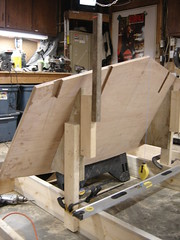We hit another milestone by getting the front transom mounted to the jig.
This process needed to be even more precise than the process of mounting the rear transom. With the rear transom, we needed to make sure that we were correct on two axes... think X,Y axis from geometry class. When we mounted the rear transom, we had to make sure our measurements were consistent on both the X and Y axes, or the whole boat would be off.
When we mounted the front transom, we had to make sure that we had correct measurements on all three axes... think X,Y and Z axis from trig classes.
This accomplishment took a lot of thought and planning. We had to make sure the transom was at the correct angle. If the angle was too small, the boat would have a flat front, and woldn't plane correctly. If the angle was too big, the bow of the boat would be too low, potentially allowing water to come over the bow. In order to accomplish this, we cut pieces of 2x6 to the correct angle, and screwed these pieces into the transom. We then screwed sections of 2x4 onto these 2x6s. The 2x4s would be then screwed into the jig frame on the floor.
In the accompanying picture, you will also see that we screwed a second 2x4-and-2x2 section onto the back of the 2x6 angle pieces, and the 2x2s stick up a little more than 6 inches from the center of the bottom of the front transom. This is because the reference line is 6 inches below the point of the transom. (Remember, we're building this upside-down for the moment, so that's why the 2x2s are pointing up.) We used two pieces of 2x2, set in equal positions relative to the center point of the transom, so that we have two points of measurement, to ensure maximum accuracy.
Next, we rough-set the transom onto the jig frame, and clamped it to the jig, so that we could tweak our settings, setting the transom in place permanently with screws. After clamping the transom to the jig frame, we used a level and a tape measure to ensure we had things absolutely accurate. We checked the height using the laser level, making sure the reference points (marked on the 2x2s) were accurate relative to the reference points on the rear transom. We checked the distance from the rear transom by measuring the distance from the front to back on both the left and right sides. We made sure the transoms were centered correctly by measuring from front-left to rear right, and by front-right to rear-left. We knew we were good to go when we verified that these measurements were the same distance.
Subscribe to:
Post Comments (Atom)

No comments:
Post a Comment